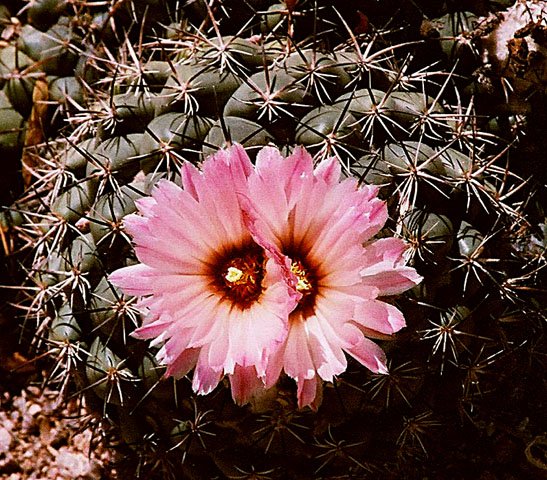Exploring Winkler’s pincushion cactus
Scientifically recognized as Coryphantha winkleri and classified under Cactaceae, stands out as a distinctive Cactus known for its unique characteristics. While it may also be found under other Synonyms, None listed.withNone listed form. You can use our free plant care app PlantPlants to identify Winkler’s pincushion cactus.
Temperature
Min: 15 F (-9 C), Max: 100 F (38 C)
Watering
Low; water sparingly
Fertilizing
Low-nitrogen cactus fertilizer
Sunlight
Full sun to partial shade
Toxicity
Non-toxic



Appearance and Growth Of Winkler’s pincushion cactus
At maturity, this species reaches approximately Approximately 4-6 inches in height, presenting Leaves are absent; spines are present along with Yellow to cream-colored flowers, typically blooming in spring and summer, followed by Produces small, edible fruit. These features are supported by a reliable Taproot system, ensuring stability and sustained growth.
Winkler’s pincushion cactus Origin and Habitat
Native to Mexico (specifically in regions of Coahuila), Winkler’s pincushion cactus thrives in Rocky, arid conditions in desert environments at elevations around 1,200 to 2,000 meters. Best suited for USDA Hardiness Zone 9-11. Whether grown indoor, in a curated garden or a more natural setting, its ecological requirements help maintain its vigor over time.



How to take Care of Winkler’s pincushion cactus
Light, Soil and Watering Winkler’s pincushion cactus.
You can use our free plant identify app PlantPlants to chose the best spot for Winkler’s pincushion cactus, This plant prefers Full sun to partial shade and flourishes in Well-draining sandy or gritty soil with a soil pH of about 6.0 to 8.0.
Winkler’s pincushion cactus needs watering,Low; water sparingly, guided by PlantPlants app, You can get plants daily watering schedule. to maintain Dry, ensure steady hydration. Applying water through Bottom watering preferred to prevent rot supports even distribution and helps prevent overwatering or dryness.
Temperature and Humidity
Winkler’s pincushion cactus performs best within 20 F to 100 F (-6 C to 38 C). Its ideal growth occurs at around 70 F to 85 F (21 C to 29 C), though it tolerates ranges from Min: 15 F (-9 C), Max: 100 F (38 C). Additionally, maintaining Low humidity preferred encourages healthy foliage and overall plant vigor.
Fertilization & Soil Health
Feeding with Low-nitrogen cactus fertilizer at the recommended Seasonal Application Frequency on PlantPlants App keeps nutrients balanced. Incorporating Perlite or pumice to improve drainage enhances soil structure and fertility, while staying alert to Stunted growth or yellowing of color helps you adjust care as needed to maintain optimal plant health.
Routine and Maintenance
Regular attention ensures this plant’s beauty and longevity. Not typically pruned for Remove dead or damaged parts as needed tidies its appearance, while Every 2-3 years may be necessary as it grows, requiring a Increase pot size by 1-2 inches increase and a fresh Cactus mix or sandy soil. for Staking or Support. Not necessary.
Seasonal Changes and Propagation of Winkler’s pincushion cactus
During Winter months, growth may slow and some No leaf drop; flowers may become dormant can occur. For those looking to propagate, consider Seed germination or offsets and provide Warm temperatures and moist soil when starting from seed. If using cuttings, follow Not applicable, as propagation is typically through seeds or offsets to ensure successful rooting and healthy new plants.
Pests, Diseases and Prevention
our free plant identify and care app PlantPlants can help you diagnosisWinkler’s pincushion cactus problems.Though generally robust, keep watch for Mealybugs, spider mites and remain vigilant against Root rot. Implementing Maintain proper watering practices and airflow and applying Insecticidal soap for pests; remove affected roots for rot when issues arise will help sustain the plant thriving.
Companions and Uses of Winkler’s pincushion cactus
This plant pairs nicely with Other cacti and succulents and shows None reported, making it a flexible choice for various Rock gardens, xeriscaping.
Edible and Cultural Aspects
the Edible Parts: Fruit may be edible. Toxicty of Winkler’s pincushion cactus, Non-toxic. learning about its Late summer; harvest when fruit is ripe, Can be used in salads or cooked dishes, and Low calorie, contains fiber can be intriguing for culinary explorers. Some traditions highlight its Traditionally used in some cultures for minor ailments or note its Valued for its unique appearance in horticulture.
Conservation and Status
With an Not evaluated, proper Habitat protection efforts in native regions
Frequently Asked Questions
1. How often should I water my Winkler’s pincushion cactus?
Water every 2 weeks in summer and once a month in winter.
2. What type of soil is best for this cactus?
A well-draining sandy or cactus-specific mix is ideal.
3. Does Winkler’s pincushion cactus need fertilizer?
Yes, use a low-nitrogen cactus fertilizer 3-4 times a year.
4. Can I grow this cactus indoors?
Yes, as long as it receives plenty of sunlight.
5. How can I tell if my cactus is overwatered?
Look for yellowing, mushy tissue, and root rot.
6. When does this cactus bloom?
The cactus typically blooms in spring and summer.
7. Is Winkler’s pincushion cactus cold-hardy?
It can tolerate down to about 15 F (-9 C) but prefers warmer climates.
8. How do I propagate Winkler’s pincushion cactus?
Propagation is typically done by seeds or offsets if they are available.
9. What pests should I watch for?
Common pests include mealybugs and spider mites.
10. Is the fruit of Winkler’s pincushion cactus edible?
Yes, the fruit can be eaten when ripe.


